Section 1: Definitions
UIU Plug-in Manager (UIUPM)
The UIU Plug-in Manager (UIUPM.exe) is a utility application designed to facilitate the installation, management and updating of the UIU Plug-ins 2.0 for use with Microsoft System Center Configuration Manager (SCCM) or with Microsoft Deployment Toolkit (MDT). The UIUPM application is also designed to facilitate the establishment, management and updating of the UIU Repository which contains both the UIU-managed driver files as well as UIU component executables.
IMP Files
UIU Import files (*.IMP) contain required driver files, driver database(s) and UIU components which are used to populate a UIU Repository from which deployed target machines will draw necessary files during OS deployment Task Sequence executions. These files are used in conjunction with the UIUPM.
UIU plug-ins 2.0
The UIU Plug-ins 2.0 is comprised of the Microsoft deployment solution-specific integrations supported by a UIU Repository. These integrations include the placement of a dynamic link library as well as the modification or addition of configurations within the deployment solution. In the case of MDT, the actions.xml is appended with a UIU section and in the case of SCCM, necessary WMI classes are added to support the UIU Plug-ins 2.0.
UIU Repository
The UIU Repository consists of Big Bang-prepared driver files, UIU-specific Driver database(s) (udb files) and UIU Components.
UIU Components
UIU Components include the required executables, (including architecture-specific uiuprep.exe) that are required for UIU operations.
Deploy or Deployment
Deliver (Advertise or Deploy) a UIU-augmented OSD Install Task Sequence to a Collection of machines.

Section 2: Requirements and Limitations
UIU Supported Hardware and SCCM Environment
Any PC machines, OEM hardware, or "white-box" hardware containing business-class components will be supported.
All supported hardware must meet the following minimum criteria:
PCs must contain at least 1Gb of free hard drive space
PC hardware must meet Microsoft requirements for applicable Operating System(s)
Note: Any Big Bang LLC produced list of supported hardware may not be complete and is subject to variation due to market advancements. (We make every attempt to stay current with of all the latest hardware and chipsets, however occasionally we aren’t made aware of new models or components released by the manufacturer.)
The supported SCCM environment must meet the following criteria:
SCCM Configuration Manager installed on Windows Server OS – Required for installation
Internet access – Required for UIU product Updates
Minimum of 20Gb free hard drive space on drives supporting the package source locations and 40Gb all distribution points associated with OS Deployment. Some distribution point configurations may require additional capacity
Supported Deployable Operating Systems:
Windows 7 (Professional or Enterprise) 32-bit and 64-bit
Windows 8.1 (Professional or Enterprise) 32-bit and 64-bit
Windows 10 (Professional or Enterprise) 32-bit and 64-bit
Windows Thin PC (WinTPC)
Technical Support Requirements
The SCCM system must be tested and proven capable of deploying a supported Windows operating system independently, (without the UIU software.)
Submission of log files and supporting information as requested by UIU Support personnel
Limitations
The UIU is not designed to image Windows Server operating systems and no technical support will be provided.
Security Access Considerations
A network access account other than a domain administrator account must be specified for software distribution point(s) in SCCM. It is recommended that an account be specifically created for that purpose. We encourage you to reference Microsoft SCCM documentation for required specific privileges.
The following section has been excerpted from the following Microsoft TechNet article and copyrights are attributed to Microsoft:
Configuring Content Management in Configuration Manager
Configure the Network Access Account
Client computers use the Network Access Account when they cannot use their local computer account to access content on distribution points; for example, this applies to workgroup clients and computers from untrusted domains. This account might also be used during operating system deployment when the computer installing the operating system does not yet have a computer account on the domain.
Note
Clients only use the Network Access Account for accessing resources on the network.
Grant this account the minimum appropriate permissions to access the software for the content that the client requires. The account must have the Access this computer from the network right on the distribution point. Because you can create only one Network Access Account per site, this account must function for all packages and task sequences for which it is required.
Warning
When Configuration Manager tries to use the computername$ account to download the content and it fails, it automatically tries the Network Access Account again, even if it has previously tried and failed.
Create the account in any domain that provides the necessary access to resources. The Network Access Account must always include a domain name. Pass-through security is not supported for this account. If you have distribution points in multiple domains, create the account in a trusted domain.
Tip
To avoid account lockouts, do not change the password on an existing Network Access Account. Instead, create a new account and configure the new account in Configuration Manager. When sufficient time has passed for all clients to have received the new account details, remove the old account from the network shared folders and delete the account.
Security Note
Do not grant this account interactive logon rights.
Do not grant this account the right to join computers to the domain. If you must join computers to the domain during a task sequence, use the Task Sequence Editor Domain Joining Account.
WARNING: The Network Access Account cannot be configured on a central administration site!

Section 3: Quick Steps for UIU Plug-ins 2.0
There are four steps required to implement the UIU Plug-ins 2.0 in your SCCM or MDT environment. Please review the applicable UIU User Guide for requirements and instructions.
- Create the UIU Repository which contains drivers, UIU executables, and other files required for use with the UIU Plug-ins 2.0
- Update the UIU
- Update the UIU Plug-in Manager application
- Update the UIU Repository
- SCCM package creation/distribution (SCCM only)
- Install the UIU Plug-ins 2.0
- Add the UIU Deployment Configuration tasks to the desired OS Deployment Task Sequence(s)

Section 4: Introducing the UIU Plug-ins 2.0
The UIU Plug-ins 2.0 was designed to alleviate the demands of upgrading the UIU in complex MDT/SCCM environments. That said, The UIU Plug-ins 2.0 is a
direct, compulsory upgrade for the UIU plug-in for MDT/SCCM (v1.x). The UIU plug-in (v1.x) products will receive limited support as deprecated versions and customers will be encouraged to upgrade to the fully supported UIU Plug-ins 2.0 product. The UIU Plug-ins 2.0 may be installed without removing the UIU v1.x product from an environment and will coexist without issue, even if both versions are utilizing the same source/deployment share. Updating the UIU Repository in a shared capacity should be migrated to use the UIU Plug-ins 2.0 technology as improvements have been made to ensure accuracy and quality. OS Deployment Task sequences should then be migrated by removing the task sequence element,
UIU Machine Configuration, which is associated with the UIU v1.x product and adding the
UIU Deployment Configuration element which is associated with the UIU 2.x product. During testing, it is acceptable for Administrators to disable the old element while testing the new element.
All OS deployment task sequences should be thoroughly assessed for remnants of the UIU Machine Configuration element, (associated with the UIU v1.x product), prior to uninstalling the UIU v1.x product. Failure to remove UIU v1.x task sequence elements prior to uninstallation will result in unrecoverable MMC errors when requesting properties on those task sequences, rendering those task sequences unusable!

Understanding Modes of Operation - SCCM
The UIU Plug-ins 2.0 is a versatile solution that may be invoked though the standard SCCM Console interface via a task element (UIU Deployment Configuration) or directly through a Run Command Line task element. Furthermore, The UIU may be invoked manually from within a Windows PE session under the direction of UIU Support. Multiple modes of operation have been provided to accommodate environmental differences as well as policy/change control restrictions.
System Center Configuration Manager (SCCM)
In SCCM, integration consists of the inclusion of a uiusms.dll in the "C:\Program Files (x86)\Microsoft Configuration Manager\AdminConsole\bin" directory as well as the addition of necessary WMI classes (MOF) to support the UIU Plug-ins 2.0. If integration is not desired or permitted, an Administrator may launch the UIU Plug-ins 2.0 from a Run Command Line task element (with the correct arguments) to achieve a successful result. Furthermore, if an Administrator is not able to control the configuration of various SCCM Remote Console implementations (distribution of a single UIU dll file), the integration of the UIU Plug-ins 2.0 may prove to be problematic and utilizing the Run Command Line task element will alleviate those issues.
For more information on alternative methods of invoking the UIU Plug-ins 2.0, Please contact
UIU Support.

UIU Plug-ins 2.0 Command Line arguments
UIU plug-in command line arguments may be used either in the UIU Deployment Configuration task element "Advanced Switches" box (
Configure Deployment settings button;
Options tab) or they may be used in the context of a
Run Command Line task element when calling UIUPrep.exe directly. Please contact UIU Support for additional information in employing the UIU via a
Run Command Line task element.
Arguments applied in the UIU Deployment Configuration task element
 may be separated by line returns for ease of viewing
may be separated by line returns for ease of viewing
-run
- Required for uiuprep.exe to execute from command line, provided as a fail-safe against accidental execution
- UIU Deployment Configuration task element supplies this parameter during plug-in execution
-licensekey “XXXX-!v4!CompanyName-XXXX”
- Required for uiuprep.exe to execute from command line
- UIU Deployment Configuration task element supplies this parameter during plug-in execution
- The license key will be evaluated upon the execution of UIUPrep
-signeddriversonly
- Optional
- Limits the driver consideration process to only OEM/Manufacturer-signed drivers
-packagepath “\\server\share\uiurepo”
- Optional
- Used to specify a specific location (drive letter or UNC path) to a valid UIU repository
- If this argument is omitted, uiuprep.exe will assume there is a repository located in the share that it is already running from
-driverudbname DB-YY-MM-DD.udb
- Optional
- Specify the use of a particular version of the UIU Driver Database (UDB files are located in the share or package source inside the “repository” directory)
Example: -driverudbname DB-15-04-01.udb
- If omitted, the UIU will determine the latest build available for utilization
-custompath “\\server\share\uiurepo\custom”
- Optional - Troubleshooting feature ONLY
- Valid drive letter or UNC path that contains raw drivers that are desired to be included in the deployment
- Capable of addressing multiple, pre-defined paths
Example: -custompath ", "
- All drivers in this location(s) will be installed to the driver store. Normal driver selection logic is bypassed
- May require a networkresource parameter in order to gain access depending upon path location
- Subdirectories of custom path will be recursed
WARNING! Adding raw drivers may affect the performance of the UIU and the resultant success of an OS deployment. Consult UIU Support to ensure appropriate use of this troubleshooting feature.
-networkresource:<path>:<domain\username>:<password>
- Optional
Example: -networkresource:\\server\path:domain\serviceaccount:password1234
- Establish a network resource (UNC path) that UIUPrep may access during an OS Deployment Task Sequence while in Windows PE
- Required when executing UIUPrep from a Run Command Line task element
- Multiple network resources may be identified
-include #### #### ####
- Optional
- Mandates the application of specific driver(s) by DriverID as supplied by UIU Support
- The driver must already exist in the UIU Repository & must already be represented in the selected UIU Driver Database (udb)
-exclude #### #### ####
- Optional
- Prevents the application of specific driver(s) by DriverID as supplied by UIU Support
- The driver must already exist in the UIU Repository & must already be represented in the selected UIU Driver Database (udb)
-offlineosdrive X
- Optional
Example: -offlineosdrive G
Example: -offlineosdrive G:\
- Forces UIUPrep to run against a specifically prescribed drive letter, normal drive selection logic is bypassed
- If no Windows installation is located on the specified drive, UIUPrep will exit and log the failure

Notes on Upgrades with side-by-side operation with the UIU Plug-in for SCCM (v1.x)
If the UIU plug-in for SCCM (v1.x) is currently installed in the SCCM environment, installation of the UIU Plug-ins 2.0 may be performed without first removing the UIU plug-in v1.x product. Both versions of the UIU plug-ins may be used simultaneously although it is obviously not recommended to include/enable both versions of the task elements to operate simultaneously in any individual task sequence.
Furthermore, the existing UIU Repository may be used with the 2.x UIU product.
- In that case, when the UIU plug-in v1.x is to be removed, care should be taken to deselect the checkbox that instructs the UIU plug-in v1.x to eliminate the UIU Repository that it initially created!
- Also, care should be taken to remove the UIU plug-in v1.x task elements (UIU Machine Configuration) from existing MDT Task Sequences prior to uninstallation of the UIU Plug-in for SCCM (v1.x).

Section 5: Using the UIU Plug-ins 2.0 – SCCM
Create UIU Packages in SCCM
Create two packages (in the Software Library>Application Management>Packages Node of the SCCM Console) called “UIU Repository” and “UIU Components”.
- The UIU Repository package must use the same source location as specified in the UIU Plug-in Manager (see Install Guide).
- The UIU Components package must use the directory labeled "components" inside the source location.
- For each package, please select "Do not create a program" during the final step of the "Create Package and Program Wizard".
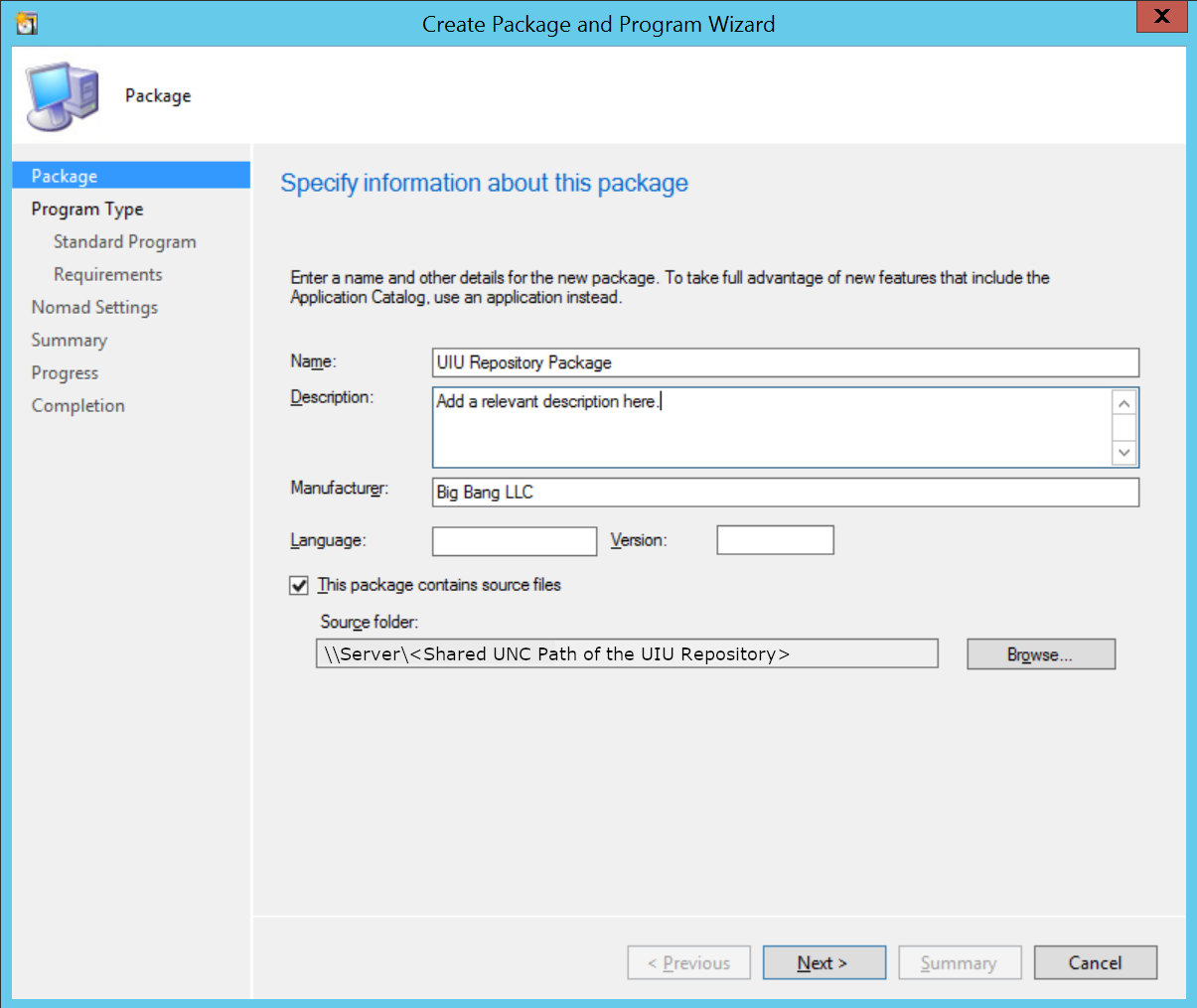
Distribute the UIU Packages (e.g. "UIU Components" & "UIU Repository")
Navigate to the following node:
Software Library>Overview>Application Management> Packages (2012)
Computer Management>Software Distribution>Packages (2007)
Right-click on “UIU Package”
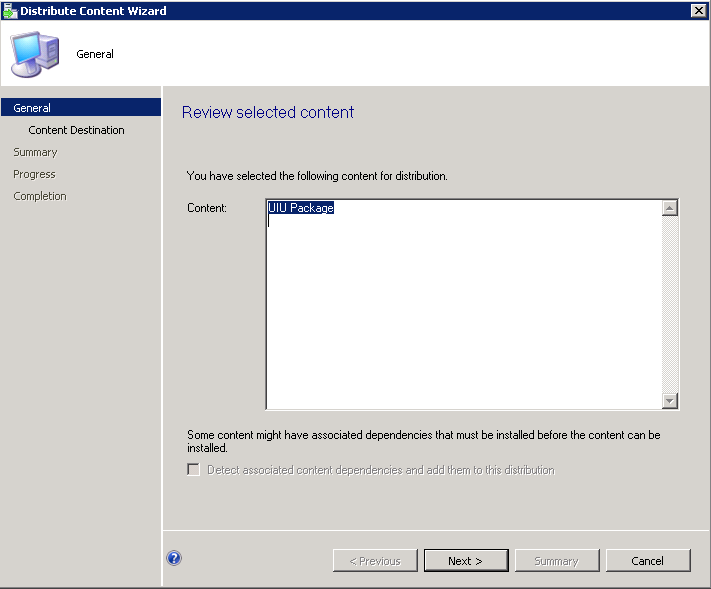 Select “Distribute Content” and click “Next” to proceed past the General screen.
Select “Distribute Content” and click “Next” to proceed past the General screen.
Select desired Distribution Point or Distribution Group(s)
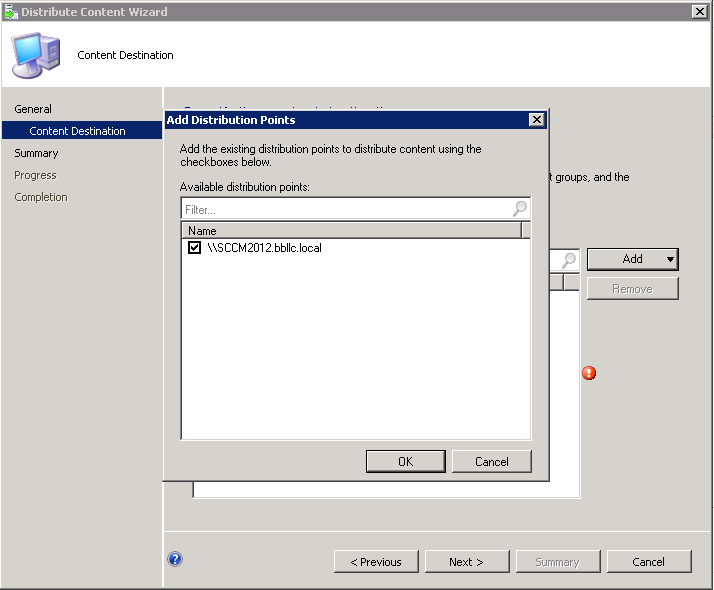 Click “Next” and then close the wizard
Click “Next” and then close the wizard

Considering SCCM Content Access Methods: SCCM 2012 (incl. R2) & Current Branch
Open the SCCM Configuration Manager Console on the SCCM Primary Site server (or Central Site Server)
A decision is now required. Which approach operating system deployments will be optimal for the environment. There are three options which vary in relative speed of deployment vs. conservation of storage space on Distribution Points…
- Local Content method: Using a technology to compress and store files on distribution points (similar to the WIM technology) & employing a Windows Store methodology wherein applications are copied locally to the target machines for staging, this method utilizes less disk space on distribution points and takes much longer to execute due to file copy bandwidth limitations.
- Access Content Directly method: Using a ‘network share’ method wherein network shares managed by the distribution network supply files to SCCM clients as needed without a local copy process. Note that all packages associated with the OSD task sequence must be set to "Copy the Content...". This method utilizes approximately twice the disk space on distribution points for all affected packages and deploys more quickly than the Local Content method.
- Hybrid method (Recommended):
Using a combination of the two previous methods, disk space may be conserved while avoiding the need to copy the large “UIU Repository” package to machines during the imaging process.
Using this method, two packages are required. The first package, labeled “UIU Components”, contains only the UIU executables and as a part of the OS Deployment task sequence, will be copied locally to the target machine.
During the execution of the task sequence the UIU software will address an SCCM management point directly to ascertain the location of the second package, labeled “UIU Repository” on the network. This hybrid process requires the “UIU Repository” package to have enabled the “Copy the content in this package to a package share on distribution points” option under the “Data Access” tab in the package properties. The “UIU Repository” package is the only package that will require this feature to be enabled, reducing the amount of disk space required on Distribution Points. Using this method, the UIU software will be able to access necessary drivers directly from the distribution point during each deployment.
If none of these methods satisfy all of the requirements of the Configuration Manager implementation or if an alternate Content Provider has been implemented, please contact UIU Support for assistance. Chances are, we’ve seen it before!

Configuration Manager Client Requirements
In order to utilize the
Access Content Directly method, all non-application packages to be included (including the Configuration Manager Client) in the OS Deployment Task Sequence must have the data access settings changes (refer to the Data Access Requirements section below) applied prior to task sequence deployment. Noting that the SCCM-included ‘Configuration Manager Client Package’
is not editable, it may be advantageous to create an editable copy of the client package regardless.
An editable copy of the package may be created using the following instructions:
Right-click “Packages” in the Software Library>Overview>Application Management>Packages node.
Select “Create Package from Definition”
Select “Configuration Manager Client Upgrade”
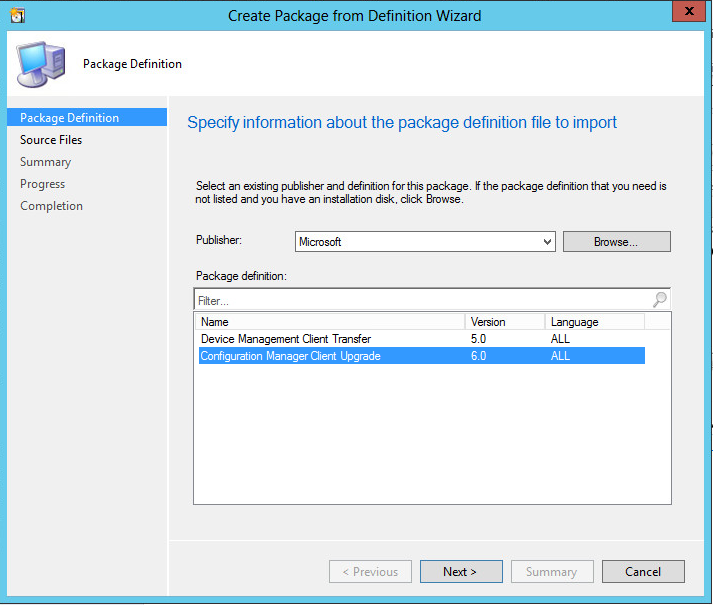 Click “Next” to continue
Click “Next” to continue
Select “Always obtain source files from a source folder”
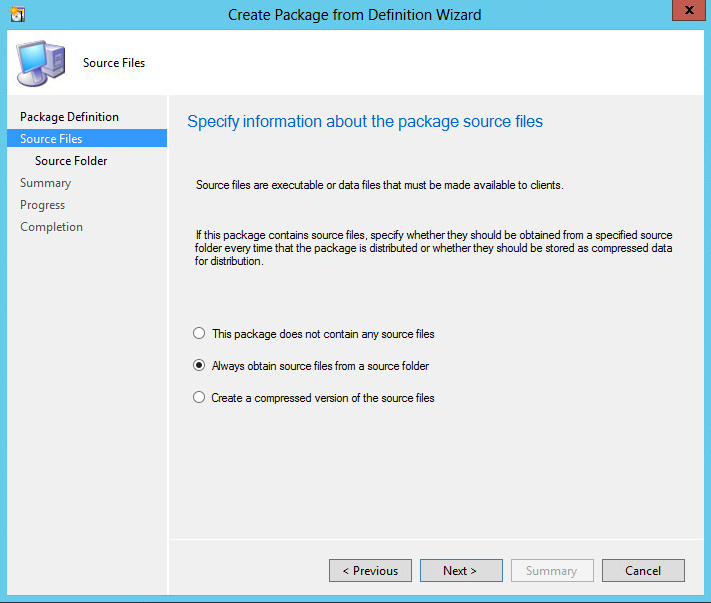 Click “Next” to continue
Click “Next” to continue
Select “Network Path (UNC Folder)”
Browse to source folder
e.g.
Network>Server Name>SMS_x64>Client
Package Definition
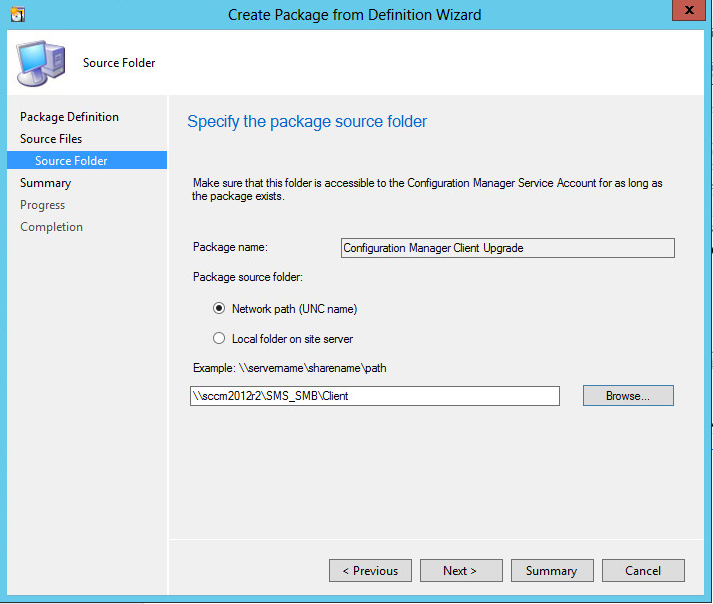 Click “Next” and then close the wizard
Click “Next” and then close the wizard
If utilizing the
Access Content Directly method, set the Data Access on the package to “Copy the content in this package to a package share on distribution points:” under Package Share Settings.
Data Access Copy Content
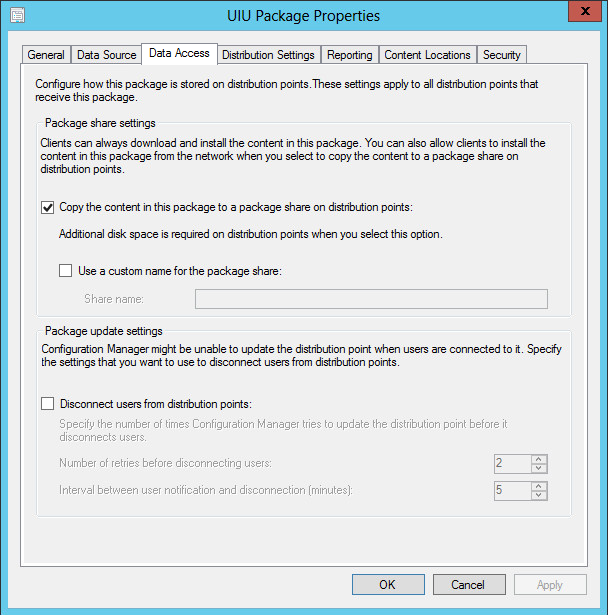 Click “OK” to proceed
Click “OK” to proceed
This enables the Deployment Option of “Access content directly from a distribution point when needed by the running task sequence”. For more information, See
Deployment Considerations below.
WARNING: Unless ALL packages referenced by a Task Sequence are configured with Data Access option “Copy the content in this package to a package share on distribution points:” under Package Share settings, the “Access content directly from a distribution point when needed by the running task sequence” option will not be available and deployments will be unsuccessful!
††These requirements are necessary to successfully Deploy a UIU-prepared Task Sequence using the "Access Content Directly..." distribution point option. They are not required for a successful deployment using the "Download Content Locally..." distribution point option, or when employing Stand-Alone Media.
Distribute the Configuration Manager Client Upgrade content
Data Access Requirements
Right-click on Package (UIU or other non-application package referenced by a Task Sequence)
Select “Properties”
Select the Data Access tab
Check the “Copy the content in this package to a package share on distribution points:” under the Package Share Settings sub-section
Copy The Content
 Click "OK" to proceed
Click "OK" to proceed
WARNING: Unless ALL non-application packages referenced by a Task Sequence are configured with Data Access option “Copy the content in this package to a package share on distribution points:” under Package Share settings, the “Access content directly from a distribution point when needed by the running task sequence” option will not be available!
††These requirements are necessary to successfully Deploy a UIU-prepared Task Sequence using the "Access Content Directly..." distribution point option. They are not required for a successful deployment using the "Download Content Locally..." distribution point option, or when employing Stand-Alone Media.
In order to determine which packages are associated with a Task Sequence, highlight the Task Sequence and select the Reference Tab on the preview pane at the bottom of the window to view a list of all referenced packages.
Task Sequence Package References
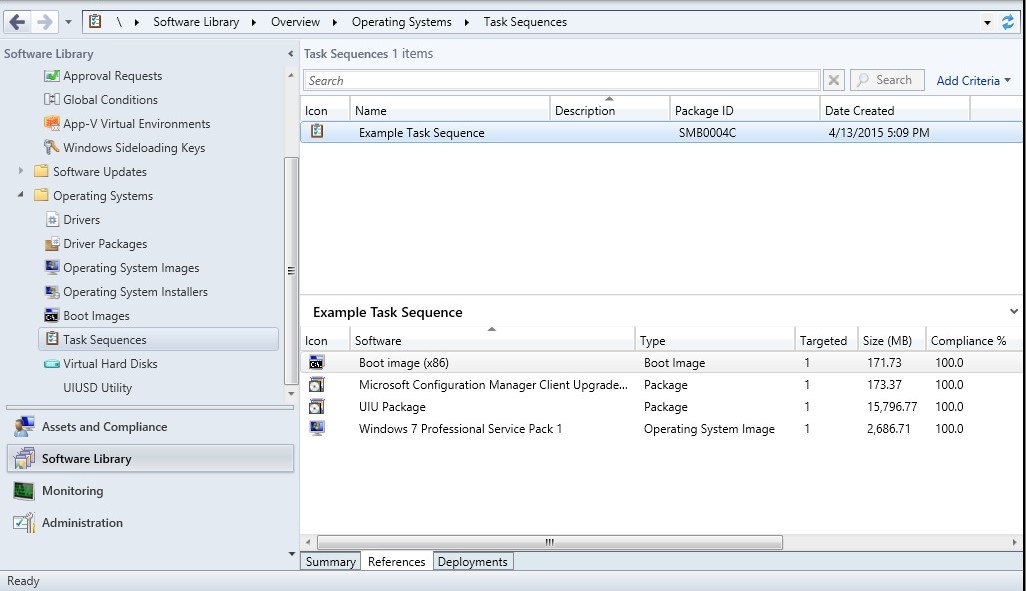

Hybrid method (Recommended)
Using the Hybrid method to employ the UIU Plug-ins 2.0 in an SCCM environment, two UIU packages will be required. The source directory used for both packages is detailed below.
This method will employ a small package as part of the task sequence to be copied locally to the target machine during OS Deployment. When the UIU task element is invoked, the UIU software will, using the parameters established in the plug-in, assess the needs of the target machine and address a larger package that contains the UIU Driver Database in order to procure only the required drivers for local storage and staging.
The first package, "UIU Components", contains only UIU-required executables from the UIU Repository's "Components" sub-folder. This small package will be included in the task sequence and must conform to the parameters that are common to or required by that task sequence.
The second package, "UIU Repository", contains the entire contents of the UIU Repository source directory, including driver files. The package ID will be provided to the UIU software when configured and not officially registered as part of the SCCM task sequence. By operating in this manner, SCCM will not consider the package as being required to fulfill the dependencies of the task sequence and thus the package will not be downloaded to the target machine, as would normally be required, prior to executing the UIU Deployment Configuration step. This package however does require that the Data Access option “Copy the content in this package to a package share on distribution points:” under Package Share settings be enabled.
Using this Hybrid method, a significant burden on the bandwidth of the subnet as well as on the storage requirements of the target machine are alleviated as the full UIU Driver Database need not be copied locally to the target machine. Additionally, this hybrid method provides the expedience of the Access Contect Directly method without requiring its additional storage requirements.
There are two methods to distribute packages; either “manually” (Software Library>Overview>Application Management>Packages) or from within the task sequence (Software Library>Overview>Operating Systems>Task Sequences). In either case, distrbution is initiated by a right-click and selection of the "Distribute Content" option.
Using the Hybrid Method, only the UIU Components package is registered as a dependency of the task sequence. Therefore, the UIU Repository package will not be distributed if said distribution is initiated via the task sequence (Software Library>Overview>Operating Systems>Task Sequences). If that distribution method is used, the UIU Repository package will additionally require that the UIU Repository package be manually distributed (Software Library>Overview>Application Management>Packages) in order for the UIU to function properly during OS deployment.
If both of the UIU-related packages are distributed “manually” (Software Library>Overview>Application Management>Packages), there is no need (from the perspective of the UIU) to initiate package distribution from the task sequence (Software Library>Overview>Operating Systems>Task Sequences).
Access Content Directly method
Using the Access Content Directly method to employ the UIU Plug-ins 2.0 in an SCCM environment, only one package will be required. The source directory used for this package will be the established UNC path of the UIU Repository share.
This method will employ a large UIU package as part of the task sequence to be accessed from the Distribution Point network during OS Deployment. The task sequence must be configured such that ALL packages referenced by the task sequence are configured with Data Access option “Copy the content in this package to a package share on distribution points:” under Package Share settings is enabled. Furthermore, the “Access content directly from a distribution point when needed by the running task sequence” option should be enabled for the task sequence.
When the UIU task element is invoked, the UIUPrep executable will, using the parameters established in the plug-in, assess the needs of the target machine and address the UIU package, "UIU Repository", from the Distribution Point directly in order to procure only the required drivers for local storage and staging. Again, the "UIU Repository" package contains the UIU Driver Database and is not copied locally to the target machine during OS deployment due to the "Access Content Directly..." setting.
Using this Access Content Directly method, as the full UIU Driver Database need not be copied locally to the target machine, a significant burden on the bandwidth of the subnet as well as on the storage requirements of the target machine is alleviated. There is an impact in storage size on the Distribution Point network as ALL packages referenced by the task sequence must be configured to “Copy the content...”.
WARNING: Unless ALL packages referenced by a Task Sequence are configured with Data Access option “Copy the content in this package to a package share on distribution points:” under Package Share settings, the “Access content directly from a distribution point when needed by the running task sequence” option will not be available and deployments will be unsuccessful!
††These requirements are necessary to successfully Deploy a UIU-prepared Task Sequence using the "Access Content Directly..." distribution point option. They are not required for a successful deployment using the "Download Content Locally..." distribution point option, or when employing Stand-Alone Media.
Local Content method
Using the Local Content method to employ the UIU Plug-ins 2.0 in an SCCM environment, only one package will be required. The source directory used this both package will be the established UNC path of the UIU Repository share.
This method is not recommended for deployment using the UIU plug-in for SCCM unless no other method is feasible.
This method will employ a large UIU package as part of the task sequence to be accessed from the Distribution Point network during OS Deployment. The task sequence must be configured such that ALL packages referenced by the task sequence are configured with Data Access option “Copy the content in this package to a package share on distribution points:” under Package Share settings is enabled. Furthermore, the “Access content directly from a distribution point when needed by the running task sequence” option should be enabled for the task sequence.
This method requires no additional configurations with respect to the Task Sequence, (e.g. "Copy the Content..." or "Access Content Directly...") and ALL packages referenced by a Task Sequence, (including the large "UIU Repository" package) will be copied locally to the target machine during OS deployment.
When the UIU task element is invoked, the UIUPrep executable will launch from it's locally copied source and, using the parameters established in the plug-in, assess the needs of the target machine and address the UIU package, "UIU Repository", from the locally copied source in order to procure only the required drivers for staging.
Using this Local Content method, as the full UIU Driver Database will be copied locally to the target machine, may present a significant burden on the bandwidth of the subnet as well as on the storage requirements of the target machine. There is no additional impact in storage size on the Distribution Point network as no packages referenced by the task sequence need be configured to “Copy the content...”.

Create an Install Task Sequence - SCCM
If modifying an existing Task Sequence, proceed to Adding the Deployment Configuration Task step below. Otherwise,
Create an Install Task Sequence for use with the UIU Plug-ins 2.0.
Navigate to the following node:
Software Library>Overview>Operation System>Task Sequence
Right-click on the Task Sequences node and select “Create Task Sequence”
Select “Install an existing image package”
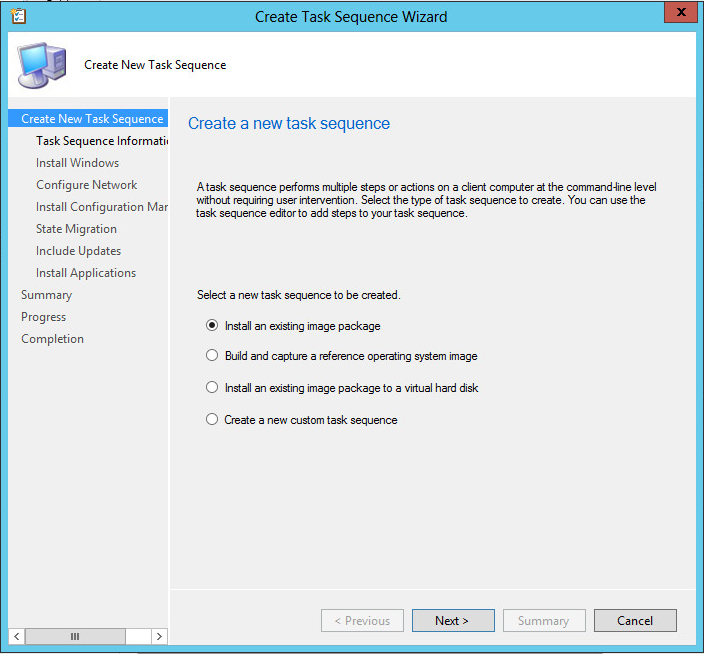 Click “Next” to continue
Click “Next” to continue
Enter the desired Task Sequence name and select a boot image.
Task Sequence Information
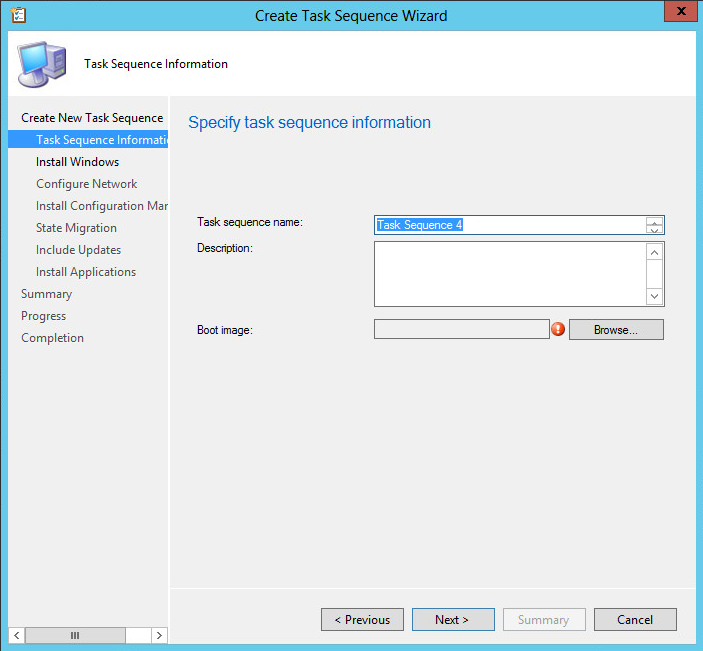 Click “Next” to continue
Click “Next” to continue
Select Windows operating system “Image package”
 Click “Next” to continue
Click “Next” to continue
Enter domain or workgroup information as desired
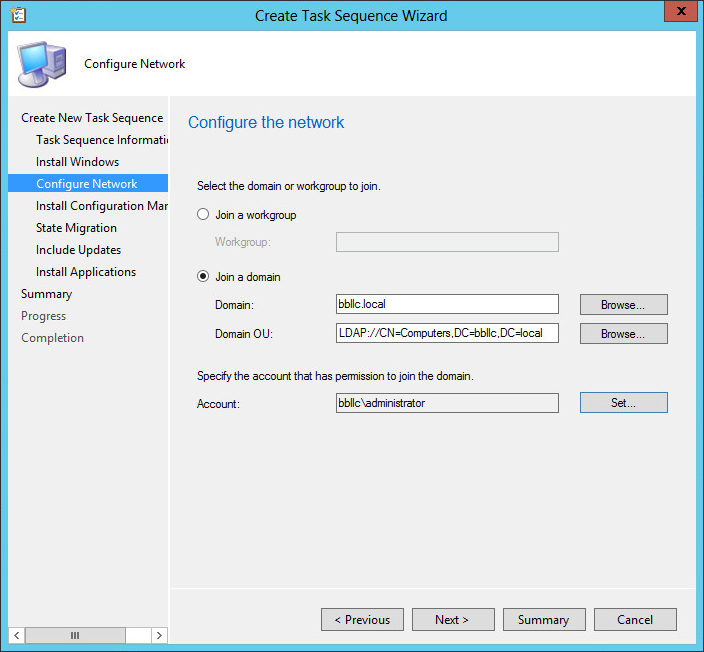 Click “Next” to continue
Click “Next” to continue
Select Configuration Manager Client Package
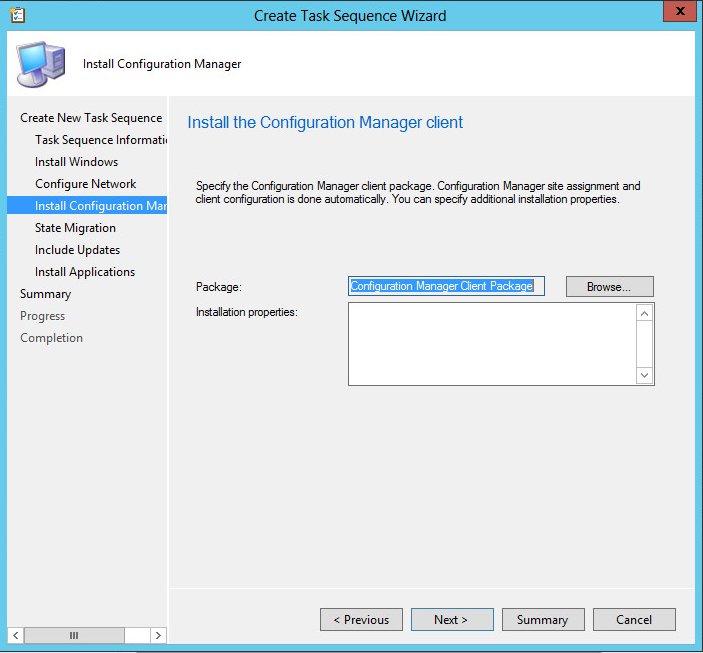 Click “Next” to continue
Click “Next” to continue
Select the package created in the Configuration Manager Client Requirements section above, “Microsoft Configuration Manager Client Upgrade”
Configure User State Migration features as desired
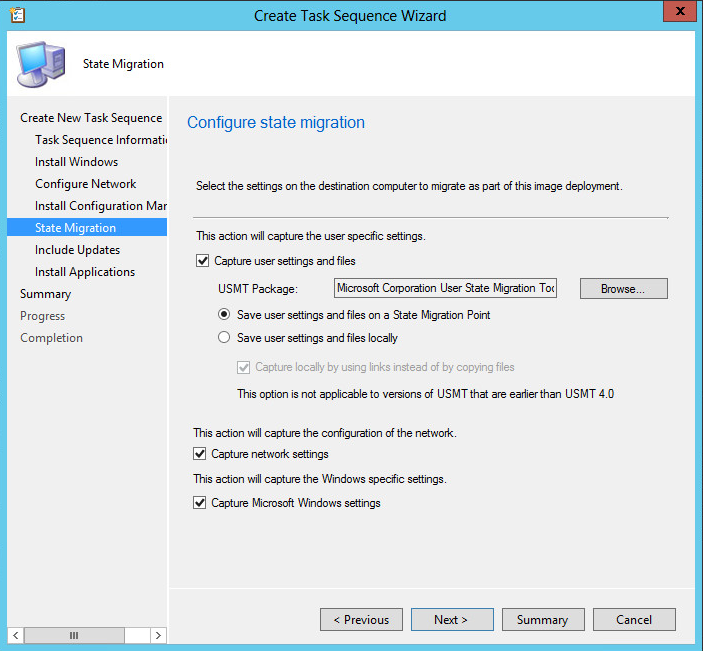 Click “Next” to continue
Click “Next” to continue
Configure “Include Updates” option
 Click “Next” to continue
Click “Next” to continue
Select “Install Applications” as desired
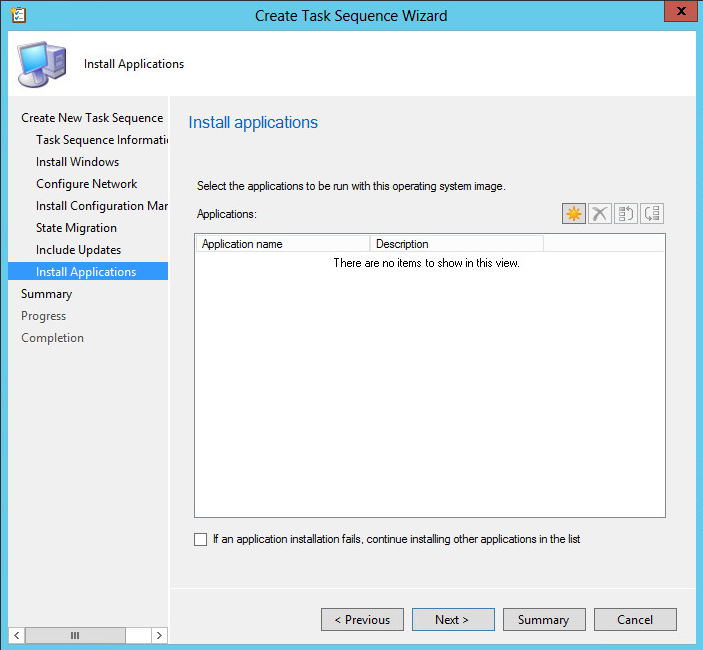 Click “Next” to continue
Click “Next” to continue
Click “Next” on the Summary window and close the wizard

Add the UIU Plug-ins 2.0 element/UIU Deployment Configuration
Add the UIU Deployment Configuration Task
Select the created OS Install Task Sequence or an existing Task Sequence; right-click and select “Edit”
Select:
Add > Universal Imaging Utility > UIU Deployment Configuration
Drag the task to a point in the sequence between “Apply Operating System” and “Setup Windows and Configuration Manager”, preferably replacing “Apply Device Drivers”.
There should be no need to utilize the “Apply Device Drivers” task as the UIU will provide all the drivers required. Our recommendation is to remove it from the sequence.
Add the UIU Plug-ins 2.0 task element
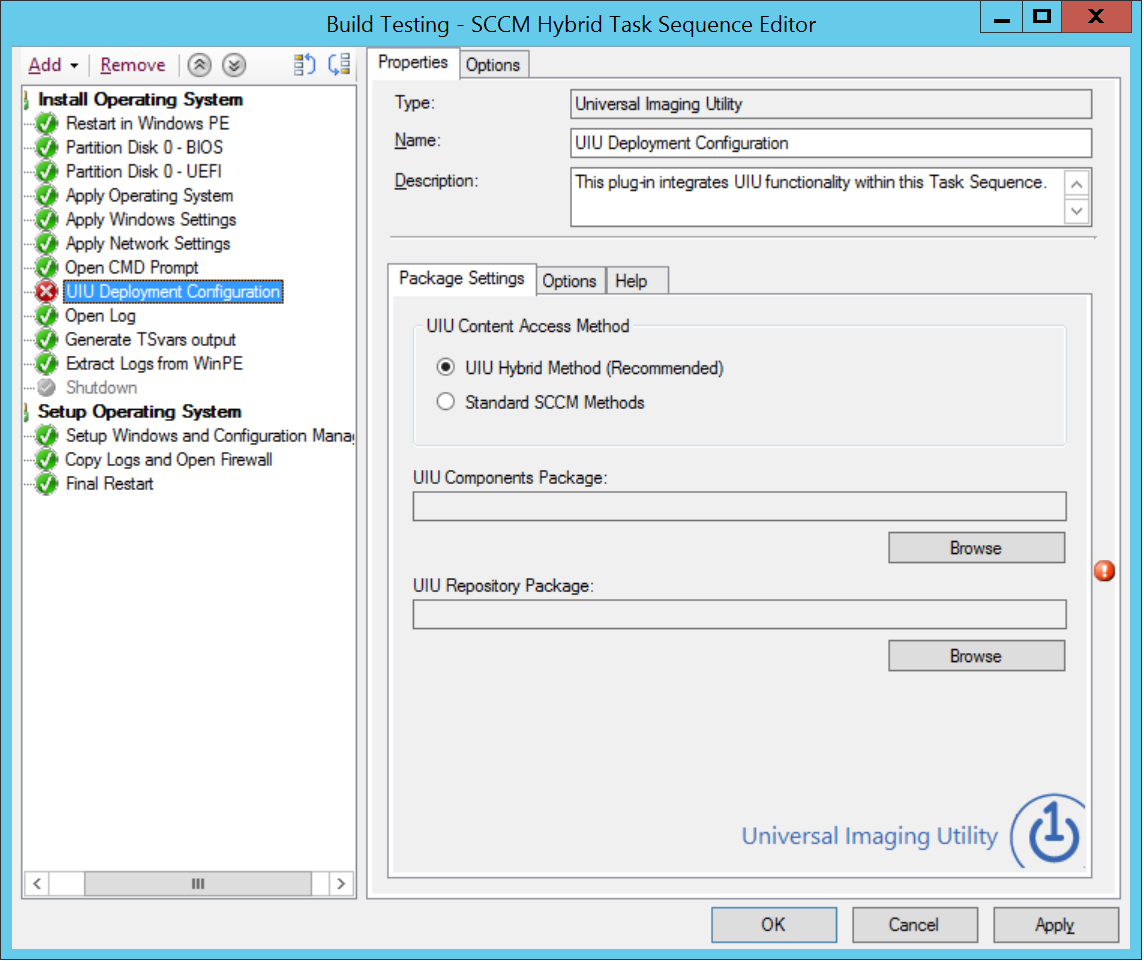
Select the UIU package(s) as required
When using the Hybrid method of content access, both the "UIU Components" and the "UIU Repository" packages are required.
These packages must be created manually by an Administrator using the established UIU Repository location as a source as discusssed at the beginning of this section. For each package, please select "Do not create a program" during the final step of the "Create Package and Program Wizard".
When using the Access Content Directly or
Off-Network (Offline Media) methods of content access, the only package required for those methods is the "UIU Repository" package. Please refer to
Content Access Methods for additional details.
Example: Hybrid Method - Select UIU packages
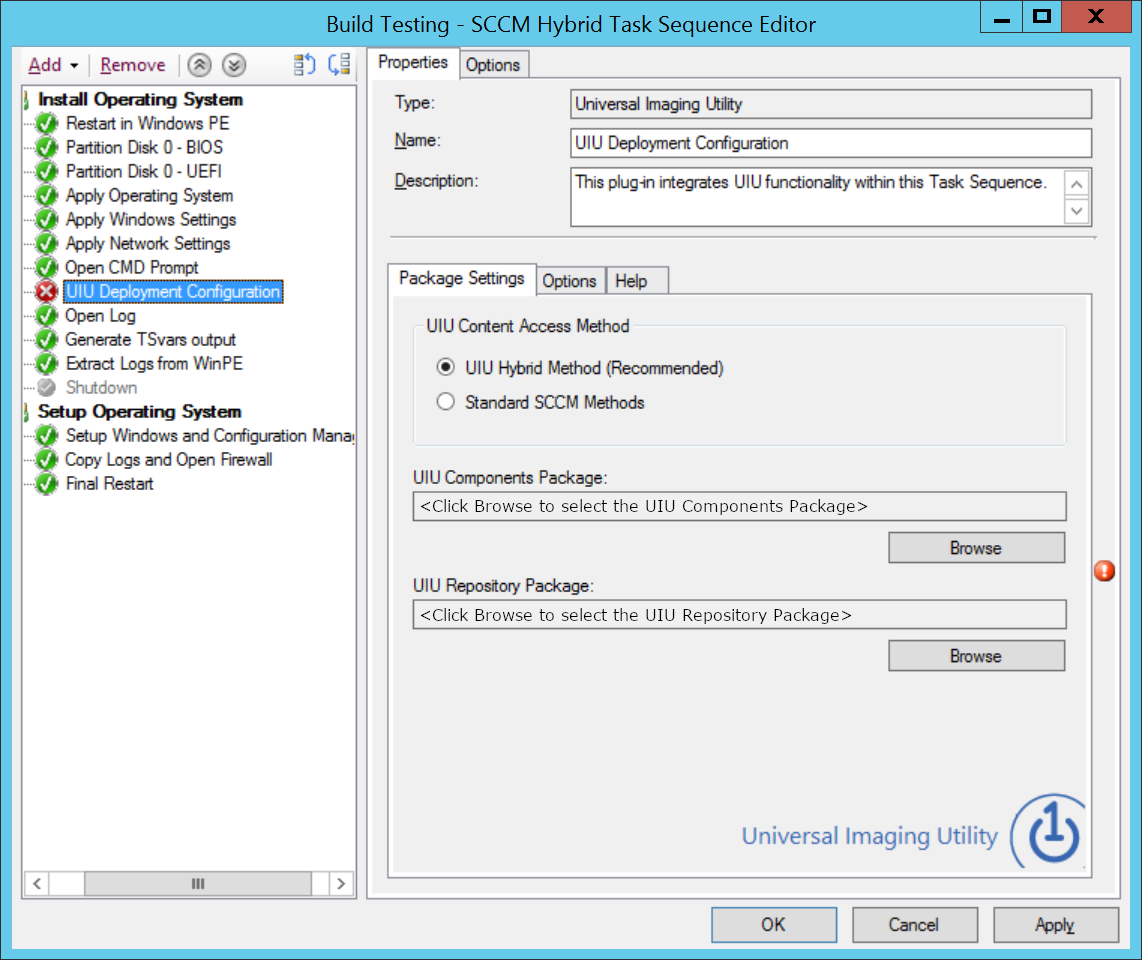
Example: Access Content Directly & Offline Media Methods - Select UIU package
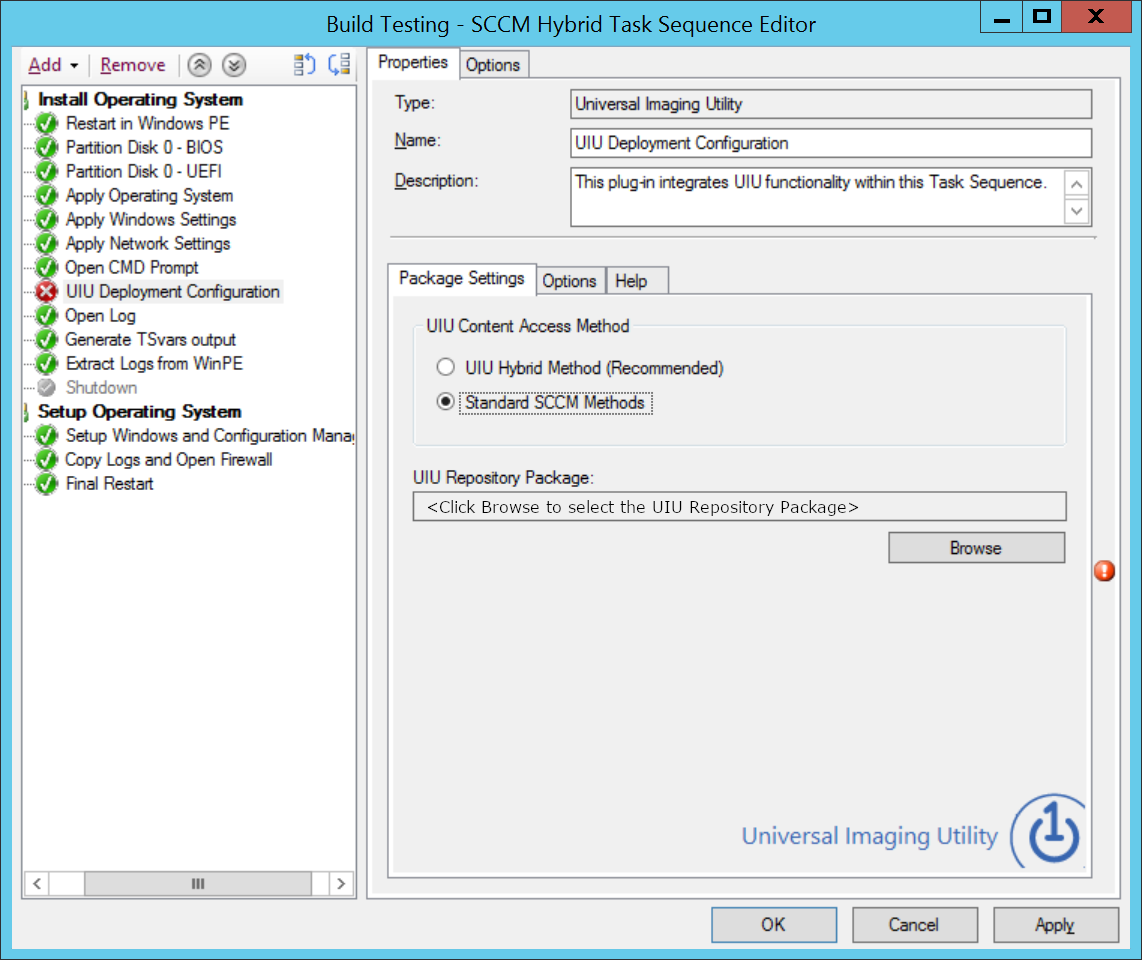
Configuration Settings - Options
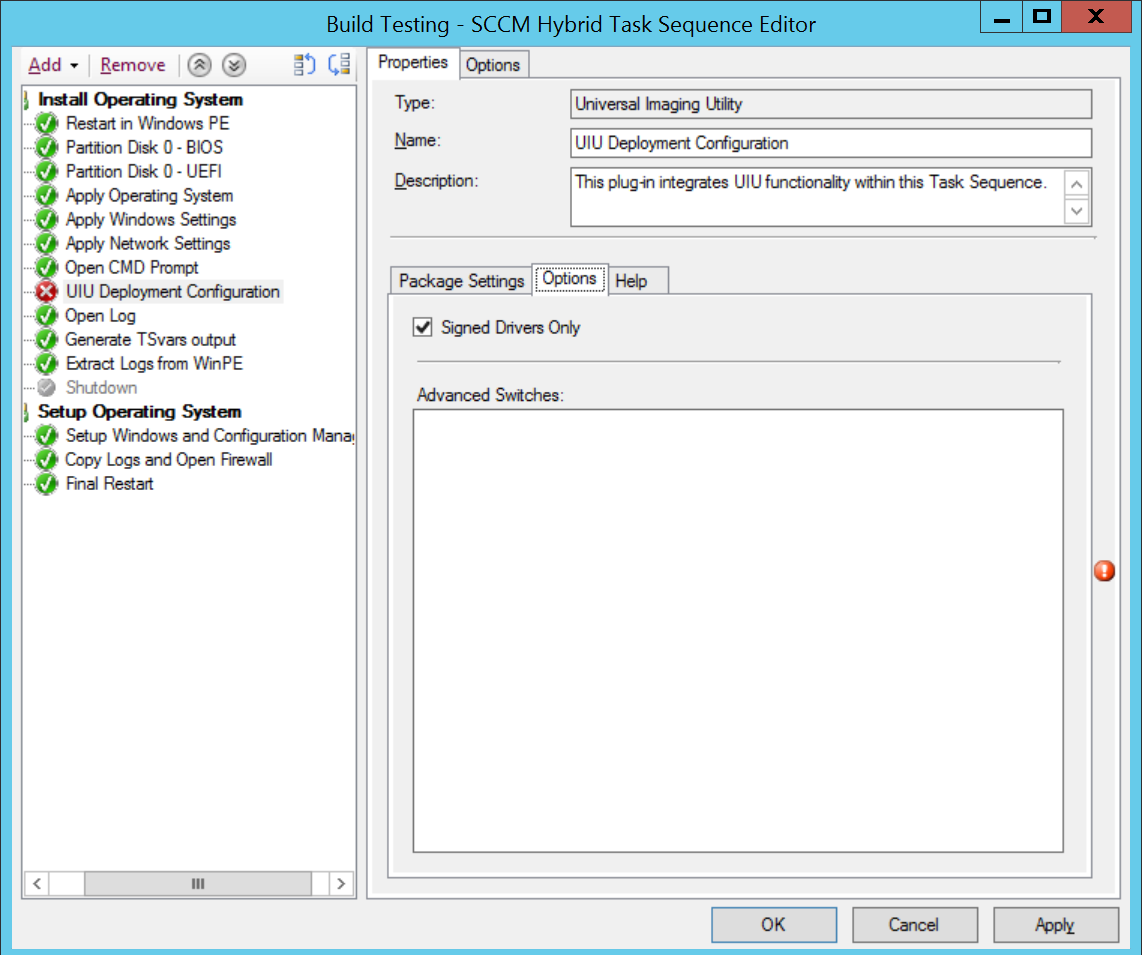 Select "Signed Drivers Only" add Advanced Switches as desired
Select "Signed Drivers Only" add Advanced Switches as desired
Select "Apply" to save the changes to the task element.
Be sure to Select "Apply"
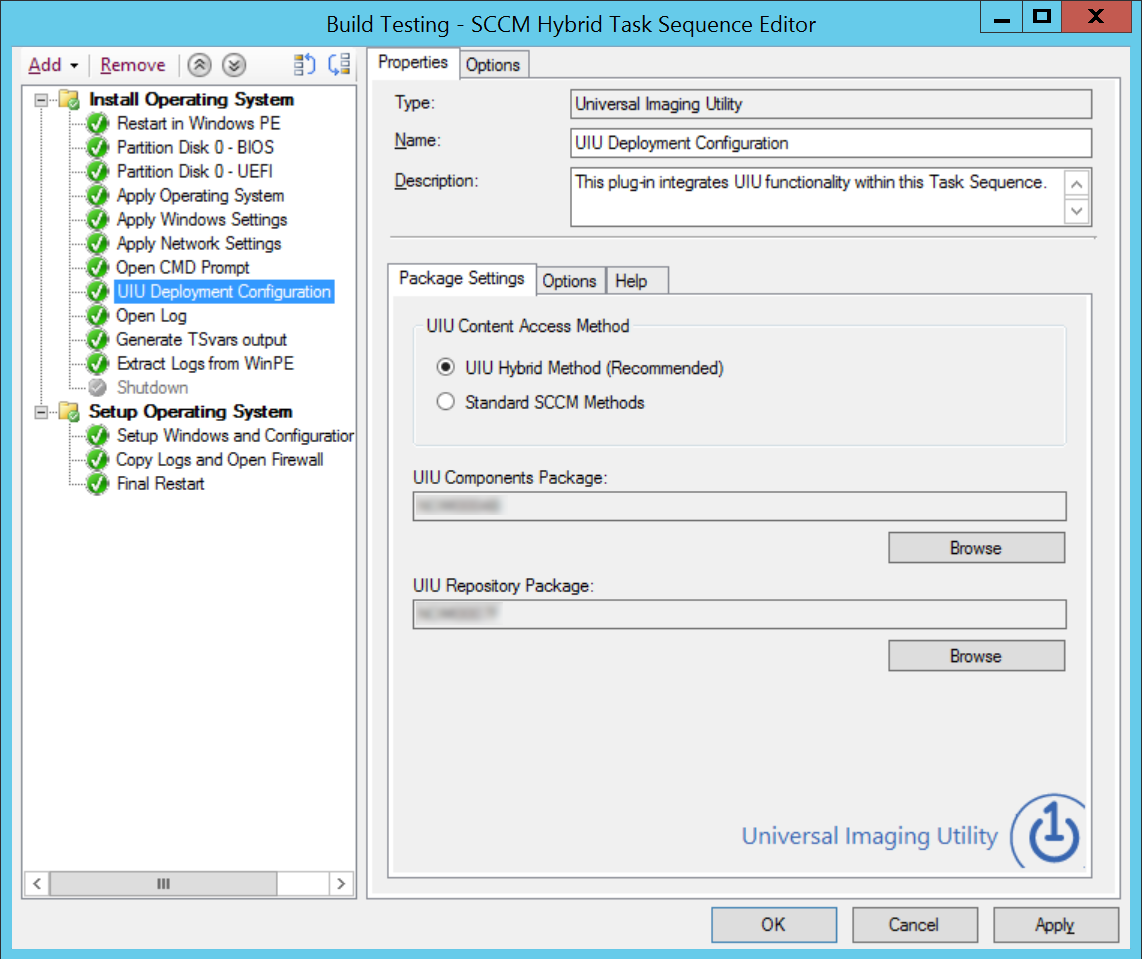 In order to save the settings!
In order to save the settings!

Section 6. UIU Plug-ins 2.0 Off-Network (Offline Media) Procedure
For Target Machines not connected to a network:
In deployment instances where it is desirable or necessary to deploy an operating system while not connected to a network or when PXE services are not available, Configuration Manager natively provides a method to produce media for off-network use, (also referred to as Offline Media). The following links will assist in creating effective Configuration Manager offline media including the use of the UIU, (USB preferred due to aggregate package sizes):
SCCM 2012
How to Deploy Operating Systems by Using Media in Configuration Manager 2012
If using the Hybrid method of exercising the UIU Plug-ins 2.0, a separate task sequence will need to be created with an integrated UIU Plug-ins 2.0 task element configured to use only the full UIU package, "UIU Repository", as the
Primary UIU Package, similar to the Local Content method.

Section 7: DEPLOYMENT
What will I see on my target machines?
Boot into WINPE.
Launch an OS Deployment Task Sequence containing the UIU Plug-ins 2.0.
Observe the typical Install Task Sequence steps through “Apply Operating System”.
As the Microsoft Client executes the “UIU Deployment Configuration” task, settings selected in the UIU configuration are initialized and UIUPrep is executed.
The UIUPrep application performs the bulk of the work for the UIU
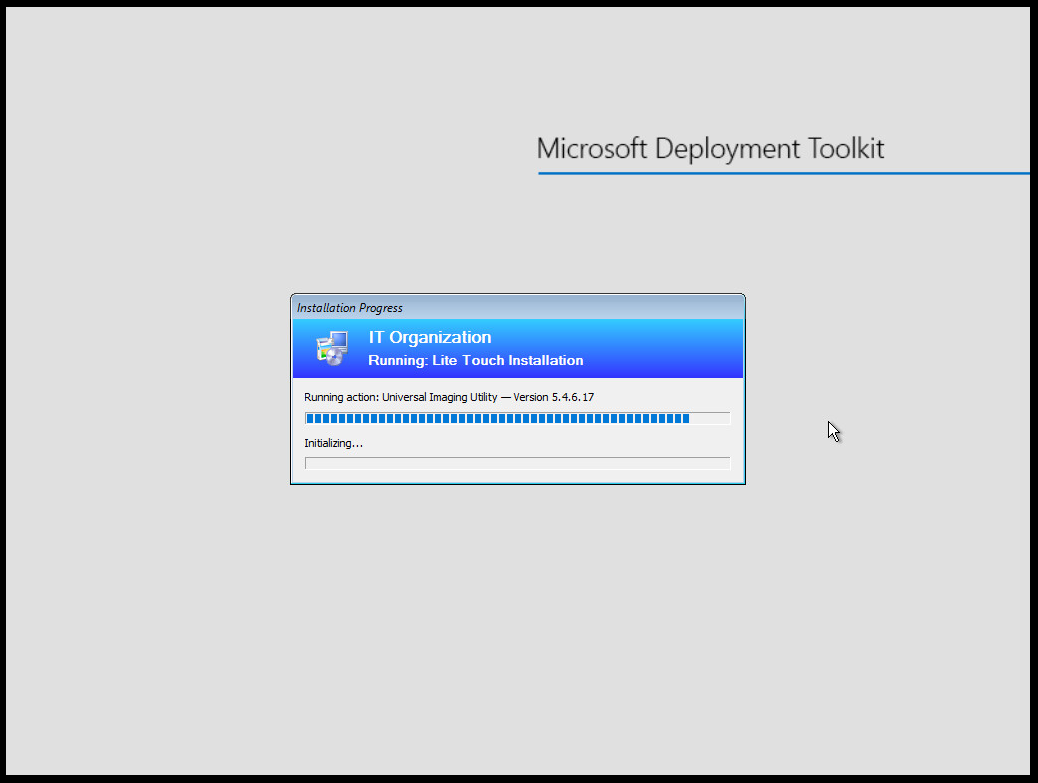
After initialization, the UIUPrep application performs the following steps:
- Copies all necessary executables and supporting files to the target machine.
- Analyzes all hardware components on the target machine for applicable Hardware IDs.
- Identifies all required UIU drivers as analyzed in the previous step and copies only the required driver files to the target machine.
- Applies proprietary technology to ensure that a complete driver set is provided to the target machine.
- Removes existing driver components in order to allow Microsoft’s driver enumeration method to function efficiently.
- Installs the copied drivers into the Local Driver Store to be presented to (and enumerated by) Microsoft mini-setup.
Upon completion, UIUPREP will initiate a restart of the target machine and invoke Microsoft mini-setup to perform Sysprep-related functions and driver enumeration.
After which, the UIU releases control to the Task Sequence for completion of any tasks that followed the “UIU Deployment Configuration” task.
The target machine operating system setup is complete and login may be initiated.

Section 8: TRIAL VERSION OF THE UIU
The UIU Plug-ins 2.0 Trial product is a fully-functional trial. Install the UIU Trial product using the instructions preceding this section.
In the task sequence, the UIU Deployment Configuration element will display information parsed from the applied UIU license key in the properties pane. The company name will be prepended with "TRIAL:", indicating that the UIU-integrated deployment is using UIU Trial product.
The Trial versions available for download include the latest executable and driver database versions and are eligible for UIU Online Updates as long as the UIU license key is valid.
Trial versions of the UIU Plug-ins 2.0 may terminate the operating system of target machines where trial images are deployed, rendering the deployed trial image unusable. Notification or warnings may be displayed on target machines after deployment.
Deployments to target machines using a Trial version of the UIU Plug-ins 2.0 are designed for test environments only, and shall not be deployed to live environment PCs.
It is imperative that no TRIAL UIU Image be deployed to any production PC. The TRIAL UIU product is intended for evaluation use only in pre-production or testing environments.
The Trial version of the UIU will install a Trial Background for the Windows login screen and all users. This Trial Background is not included in the licensed version of the UIU.
Some antivirus applications may mistakenly identify BBGINA.DLL and/or TWUNK.DLL as threats. These two files are necessary for the UIU TRIAL product to function and should not be removed, modified, moved or quarantined.

Section 9: Updating the UIU Plug-ins 2.0
Please review
Section 8 (Tour of the UIU Plug-in Manager) of the UIU Plug-ins 2.0 - SCCM Install Guide for specifics on updating a UIU License key, updating the UIU Plug-in Manager (UIUPM) application, and
updating the UIU plug-in components and driver database/files online (requires Internet connectivity).
Scripting UIU Online Updates
Command Line Options are available to allow for the scripting of UIU components, driver database version and driver files (based on driver database version). These updates may be scripted using a batch file or Microsoft Scheduled Tasks, etc.
Referring to the UIU Plug-in Manager application, in the Repository Management section, the
Script Updates button will provide a sample command line based on the machine that the UIUPM is executed on. This assumes that a valid UIU License Key has been applied and that an appropriate UIU Repository UNC path has been established and provided.
If the scripted updates are to be executed from a machine on which the UIU Plug-in Manager application has not been or will not be executed, additional steps must be taken to focus the UIUPM at the appropriate location.
First, the machine that will initiate the scripted UIU Online Updates, the Admin Machine, must be informed as to the location of the UIU Repository to where the updates will be applied, using the following command:
"\\server\path\uiupm.exe" -CHANGEREPOSITORY "\\server\<UIU Repository UNC path>" domain\AdminUser Password
Next the Admin Machine must be informed of the valid UIU License Key required to obtain UIU Online Updates successfully, using the following command:
"\\server\path\uiupm.exe" -licensekey "XXXXXXXXXX-!v4!CompanyName-XXXXXXXX"
Note that the UIU License Key may be applied in the same command line as the actual update parameters. It is represented individually for the use case wherein License Keys are protected and not made available/obvious to non-Administrators.
Alternative Example:
"\\server\path\uiupm.exe" -licensekey "XXXXXXXXXX-!v4!CompanyName-XXXXXXXX" -UPDATE COMPONENTS DATABASE DRIVERFILES CLEANUP
Once the Admin Machine is aware of the location of the UIU Repository to be affected and of the UIU License Key, UIU Online Updates may be initiated using the following command:
"\\server\path\uiupm.exe" -UPDATE COMPONENTS DATABASE DRIVERFILES
- DATABASE refers to the version of the UIU Driver Database (UDB)
- DRIVERFILES refers to the individual driver files that are relevant to the version of the DATABASE
- COMPONENTS refers to UIU executables, namely UIUPREP.EXE (x86 & x64)
- CRC refers to the validation of each Driver File during download
- CLEANUP refers to the removal of driver files that are not represented in any of the available DATABASE versions (UDBs)
For additional details, please refer to
Section 8 (Tour of the UIU Plug-in Manager) of the UIU Plug-ins 2.0 - SCCM Install Guide.
As environments and implementations may vary drastically, please contact UIU Support with any questions regarding the optimal implementation of UIU Plug-ins 2.0 scripted Online Updates.

Updating the UIU License Key in UIU Plug-ins 2.0 for SCCM
Due to security upgrades, all new UIU license keys with an expiration date after December 31, 2019 require the use of the new updated software, both the UIU Plug-in Manager — UIUPM.exe (2.2.3) — and the components software — UIUPrep.exe (5.8.1).
The necessary steps are detailed in the following blog article.
For each instance of the Configuration Manager Console where the UIU Plug-ins 2.0 is installed, including any SCCM Primary Site Server(s) and any SCCM Remote Console instances:
- Launch the UIU Plug-in Manager (UIUPM.exe).
- Select Licensing from the Main menu.
UIU Plug-in Manager application - Licensing

–––
- Enter the new UIU License Key.
UIU Plug-in Manager application - Licensing
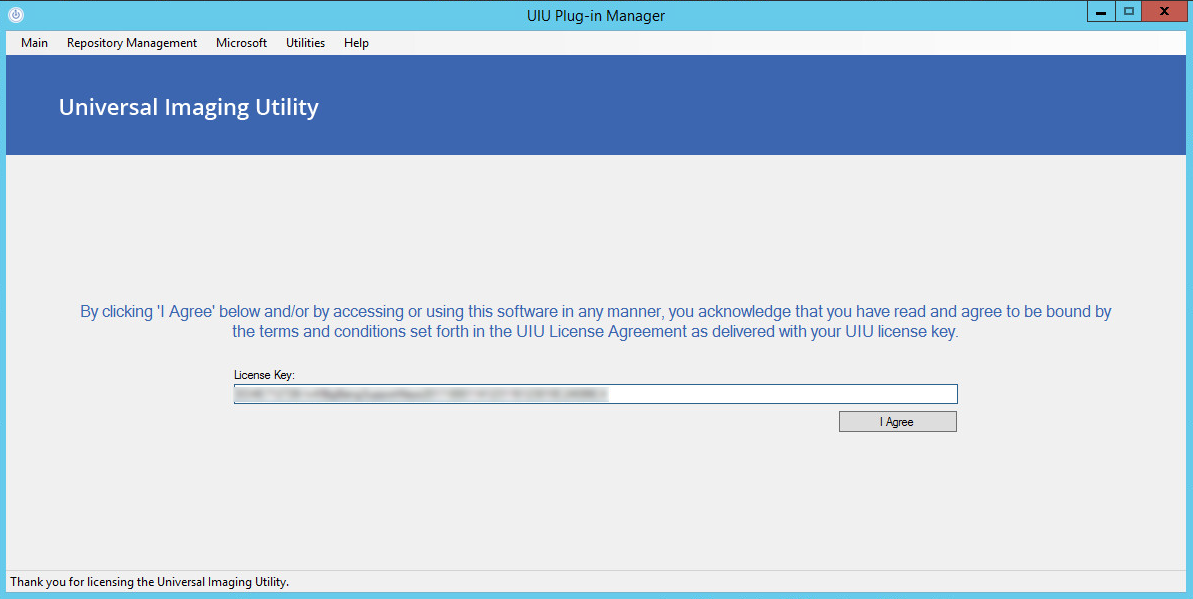
Select “I Agree”
- Ensure that there are no instances of the Configuration Manager Console running on the system and Select "Microsoft System Center Configuration Manager" from the Microsoft menu.
UIU Plug-in Manager application - Microsoft menu

–––
- Click "Install Plug-in", select the appropriate check boxes if they are not already selected by default, and click "OK".
UIU Plug-in Manager application - System Center Configuration Manager
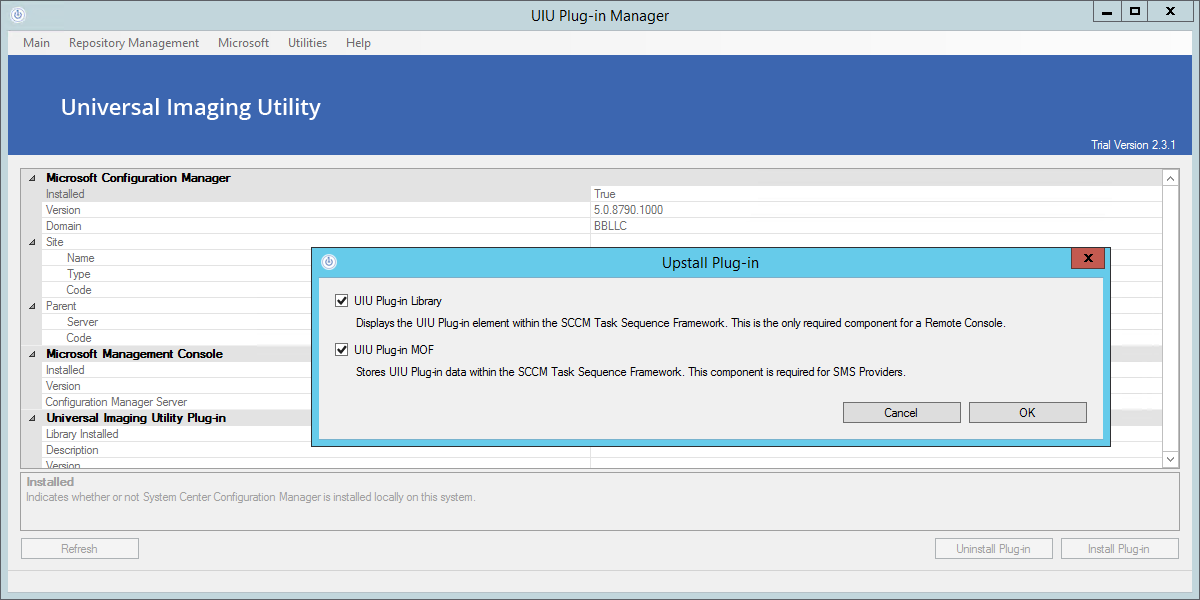
-- If installing on an SCCM Primary Site Server, select both components.
-- If installing on an SCCM Provider (stand-alone), select only the MOF component.
-- If installing on a "remote" Configuration Management Console, (e.g. Administrator PC), select only the "UIU Plug-in Library" component.
Note: As of version 2.3.0.0 of the UIU plug-ins for SCCM, it is no longer necessary to trigger an apply event in each UIU-integrated task sequence in order to update the UIU license key in the corresponding task sequence elements. When the UIU plug-in for SCCM is updated using the UIU Plug-in Manager application, the UIU-integrated task sequences are automatically updated with the UIU license key that had been registered with the application at that time.
In the instance where the UIU is executed via Run Command within a Task Sequence, the expired UIU License Key must be replaced with the new UIU License Key.
Even in the instance where the plug-in has not been integrated, be sure to also update the licence key in the Plug-in Manager.

Offline Updates
The required files are listed below:
The following instructions apply to both SCCM and MDT, as both plug-ins are managed by the same components within the UIU Plug-in Manager (UIUPM).
To update the UIU Plug-in Manager (UIUPM)
- Download from the first link above, extract UIUPM.exe, and replace your existing instance of UIUPM.exe with this file.
- The UIUPM is not installed and is a standalone application. Its configuration is saved and will connect to any new instance of UIUPM.exe when executed from the same PC.
- After replacing UIUPM.exe, simply launch the UIUPM to continue managing your UIU Repository and UIU Plug-ins.
To update UIU Program Files (in this particular case, UIUPrep)
- Download from the second link above, and extract the IMP file contained therein (in this case, p5600.imp).
- Launch the UIUPM and select the Repository Management screen from the main menu.
- Ensure that the repository path selected (above) is the desired recipient of the imported database.
- Click on the Import Repository button.
- Navigate to your extracted IMP file, and select Open.
- The UIUPM console will flash briefly (very small file(s)), and your UIU Program Files have successfully updated.
- (SCCM only) Finally, once all desired UIU updates have completed, perform an "Update Distribution Points" operation in SCCM on either or both UIU packages that you have distributed in your environment. If you are not using the UIU Components package or are using your own repository package, update as appropriate for your environment.
Important note:
Everything below “Repository Update Options” on the right-hand side of the screen applies to online updates only.
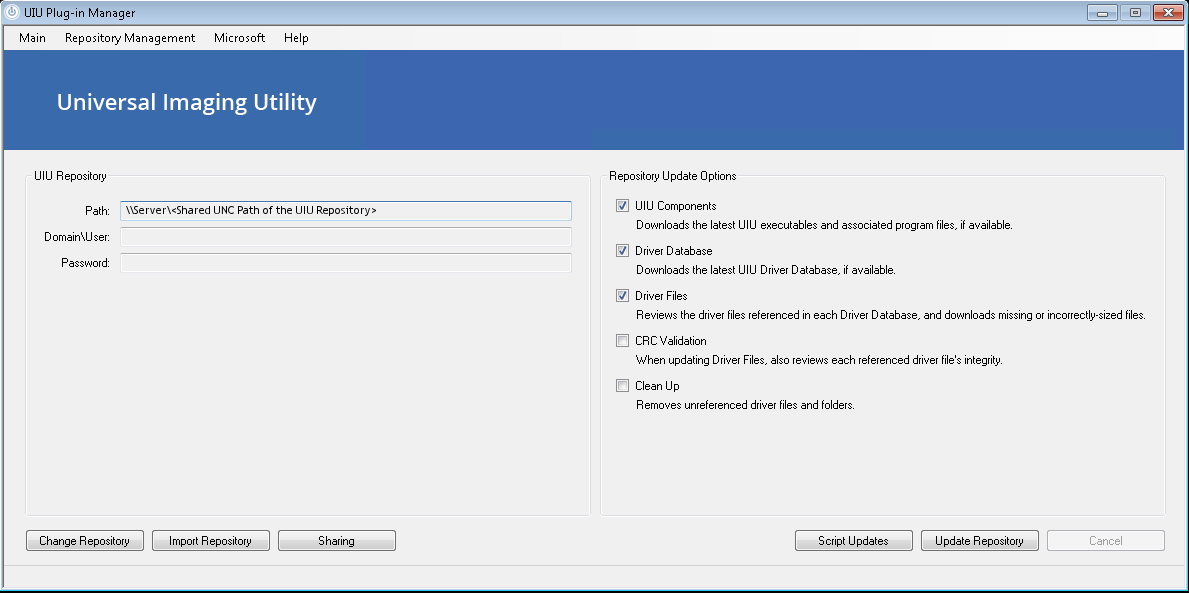 For import functions (i.e. offline updates), please leave these settings at the default configuration.
For import functions (i.e. offline updates), please leave these settings at the default configuration.
To update UIU Driver Database (not applicable here, but it will be shortly, so I’ve included it)
- Download from custom link delivered by Big Bang, and extract the IMP file contained therein.
- Launch the UIUPM and select the Repository Management screen from the main menu.
- Ensure that the repository path selected (above) is the desired recipient of the imported database.
- Click on the Import Repository button.
- Navigate to your extracted IMP file, and select Open.
- Import progress will be noted in the lower left bar of the UIUPM.
- (SCCM only) Finally, once all desired UIU updates have completed, perform an "Update Distribution Points" operation in SCCM on either or both UIU packages that you have distributed in your environment. If you are not using the UIU Components package or are using your own repository package, update as appropriate for your environment.

Section 10: UIU Discovery Tool – UIUDT
The
UIU Discovery Tool: (UIUDT) is designed to analyze machines in your environment to determine their compatibility with the UIU Driver Database.
When using the UIUDT to either pre-determine if drivers will be missing, (potentially leading to blue-screen BSOD errors) or when experiencing driver “bangs”, please notify UIU Support immediately by submitting the results file to
UIU Support. Thank you!
How do I get the UIUDT?
The new UIU Discovery Tool v2.0 may be downloaded from
UIU Support Tools Download.
How do I run the UIUDT?
ALERT: The UIUDT process has changed! Please refer to the
UIUDT v2.0 Instructions before attempting to execute the new UIUDT.

Section 11: Technical Support
As part of the licensing agreement with Big Bang LLC, technical support for the Universal Imaging Utility (UIU) is available for one year from the original purchase date. Big Bang LLC technical support can be reached through the following methods:
On Line Support Form (Preferred):
UIU Support
Direct Telephone Support: 414-369-5020
(M-F 9:00am-5:00pm Central:GMT-6)
Email Support: support@bigbangllc.com
Send UIU Support an email
When contacting support, please be ready to provide the following information:
The SCCM system must be tested and proven capable of deploying a supported Windows operating system independently, (without the UIU for SCCM software.)
Version of the UIU plug-in
Revision of the Driver Database (including Custom Driver Packages, and any SCCM Driver Packages)
UIU License Key
Version of SCCM (2007 or 2012, etc.)
Version of Windows Server OS including Service Pack
Process used to create an operating system image used in the Install Task Sequence, (Build & Capture, DISM\ImageX Capture, etc.)
PC Operating System and Service Pack
PC Make/Model of Recipient (deployed to) machine(s)
UIU log file (C:\Program Files\UIU\UIULog.htm)
Nature of the Problem; Blue Screen, Continual Reboot, Missing Hardware Driver, etc.
In situations relating to missing or incorrect hardware drivers, please be able to provide the following files from the Recipient Machine:
Windows 7, 8.1 and 10 (32-bit or 64-bit)
UIU log file (C:\ProgramData\UIU\UIU.log) ~ hidden directory by default
SETUPAPI Log (C:\windows\inf\setupapi.dev.log)
SETUPAPI Setup Log (C:\windows\inf\setupapi.setup.log) -- Windows 8.1 & 10 only
NOTE: Technical Support and Updates are only available for operating systems and hardware currently supported by the UIU. Please see the section titled “Section 1: Requirements and Limitations” for more details.
Please review this User Guide
before employing
the Universal Imaging Utility Plug-ins 2.0 with SCCM.